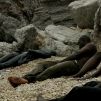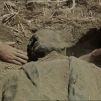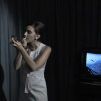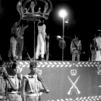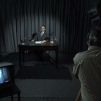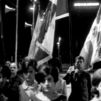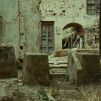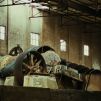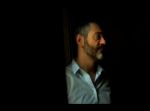CACT E-STUDIO
How does art formulate the past and remember the future?
Stefanos Tsivopoulos was born in 1973 in Prague. He lives and works mainly between Amsterdam and Athens.
His work refers to the past, the collective and individual memory, the genius loci and the public discourse, while on the parallel it also deals with the technology of the image and the historicity of cinema and television aesthetics, based on the complementary relation between fiction and documentary. His methods are apparently similar to those of a historian; seeking material traces of the past by means of a thorough and archival research, detecting and indicating available visual sources along with written and oral testimonies, and investigating his subject by means of a comparative and interdisciplinary approach.
However, the artist is a creator, not an imaginative interpreter.
He does not merely aim at visually transcribing an established –or even an alternative– narrative of the past into the codes of contemporary filmic language. He rather focuses his interest on how the past is illustrated, turned into an image, shaped into memory and how it acquires the regime of truth. According to Tsivopoulos, documentary and fiction are not the two opposite sides of a bipolar scheme but belong to interrelated cognitive fields, since they both dialectically take part in shaping the reality effect. He treats visual documents as a construction intervened by collective representations, an image that, ab initio, structurally incorporates specific connotations and interpretations moulding significantly not only our perception of “what actually happened” but also the way we define our present and contemplate our future through the choices we make on how we narrate the past. He is therefore interested in the imagined, illustrated and mediated memory of the past which he treats as a fundamental element of the contemporary hybrid consciousness that is constantly shaped and re-evolving in a state of diaspora, displacement, dislocation and absence of a coherent frame of reference.
The experience of forced dislocation and migration due to political persecution greatly defined his family history and contributed decisively to Tsivopoulos’ choice to make use of the constant streaming between places as a basic component in his work. His meticulous preoccupation with the material evidence of the past arises almost inevitably as an exhausting pursuit of self knowledge that is constantly developing by means of a reflective wandering through places with which he shares visible or invisible bonds and images burdened with contested memories. Tsivopoulos is a choreographer of the relation between places and histories· he visits them, and in the same time he re-interprets and invents them keeping the safe distance from both critical review and nostalgic intimacy. The balance between identification and detachment is the crucial site for the formation of the subject, Tsivopoulos’ strongest and long-lasting engagement.
Through his work he intends to raise questions on ambiguous periods of the past, such as the cold war era or Greek junta. In his work Lost Monument (2009), he employs photographic archives and TV documentaries, which refer to the erection, the violent removal and the adventurous story of the statue of the US president Harry Truman that was erected in Athens in 1963. People assaulted the statue thus stating a profound feeling of negative reaction toward the US political and economical penetration in post-war Greece and Tsivopoulos draws from all this in order to create an allegorical, fictional narrative describing the successive transfer of the statue in various regions of Greece and Turkey. In Tsivopoulos’ new version of the story, these removals occur due to the discontentment caused by the inability to identify the statue; what is this statue? Whom it belongs to? Is it an ancient or a new art work? All these unsolved matters show that the well-known conceptual context is inverted causing discomfort to those who see the statue. An inexplicable repulsion, connected with general inability to communicate, runs through various social and cultural groups triggering a profound need to take off the burden of the ambiguous memory incorporated in the unwelcome finding. An ambivalent and unidentified memory which provoked a series of unresolved matters or contradictory interpretations is also the basic problem for the historical subject crushed in the mechanisms of political power and public manipulation.
In 2007 Stefanos Tsivopoulos participates in the 1st Athens Biennale with Untitled (The Remake). In this new production, he encompasses archival footage from the years of the 1967-73 dictatorship, material from official celebrations and festivities, dramatic representations of ancient times’ highlights, along with some sequences that have been saved from the rehearsals of news bulletin broadcasters of the period. Taking into consideration the historical and technological circumstances under which the Hellenic Radio Television was then established and its role as a means of obedience propagating the regime’s doctrine, Remake is an allegory on the technological television means used to create and reproduce the reality effect within certain historical periods – a reality at the service of propaganda.
In 2010, he took part in Manifesta 8 with the work Amnesialand, an original production especially conceived for this roaming biennale of Europe. That year, the hosts of the event chose the region of Murcia in southeastern Spain, where Tsivopoulos presented an installation consisting of two parts. The first part, entitled An image dies when the gaze that lights on it has disappeared, was a slide installation on three projectors of 120 archival photographs of early 20th century house interiors in Murcia. The second part of the installation was the film Amnesialand, in which he composed archival filmed material and his own video footage shot in the region.
The viewer witnesses the everyday life in a period of prosperity due to the region’s richness in minerals in contrast to the current state of misery and the environmental crisis that followed when the industrial era came to an end in the second half of the 20th century. Simultaneously he hears a dialogue between a female and a male character that speculate about a mysterious event that is said to have caused a state of collective amnesia; the gradual alteration and destruction of all visual evidence which in turn leads to the loss of the collective memory is the aforementioned event.
Tsivopoulos processes the original material in a unique way attempting to reveal certain aspects which were latent beforehand. Thus, the photographs of the city's rich bourgeois buildings and interiors cease to symbolize the residents’ social status and welfare –based on the exploitation of human labour and natural resources–, renounce their commercial function and finally become the material evidence of a historical period. But what history held in store for this evidence is definitely ironic; these brittle negatives were damaged by dust and metal debris on the glass plates – remnants of the mining activity. The long-forgotten and disregarded memory of strenuous labour in dangerous and unhealthy conditions in the mines surprisingly endures through time and dramatically affects the viability of the representations that excluded this remembrance.
Certain types of reflection –mainly archives, memory, oblivion, history and the means of visualizing and interpreting the past– are structurally intertwined in Tsivopoulos’ work. Even though he makes a clear reference to place and time on the outset of each one of his works, the way he deals with his themes results in transcending time and space determinism, bringing forth universal issues, mainly concerning the perception of subjectivity and the moulding of consciousness through the collateral processes of stimulating and obliterating memory. If we try to look at his art through this lens, we finally realize that the main issue raised here is not the conception and interpretation of the past, but the formation of the self through the awareness of the invisible or forgotten layers of past history and memory. It all comes as the necessary procedure that enables our way out through the present inefficacies to a creative future, possible for us to imagine. A future already started.
